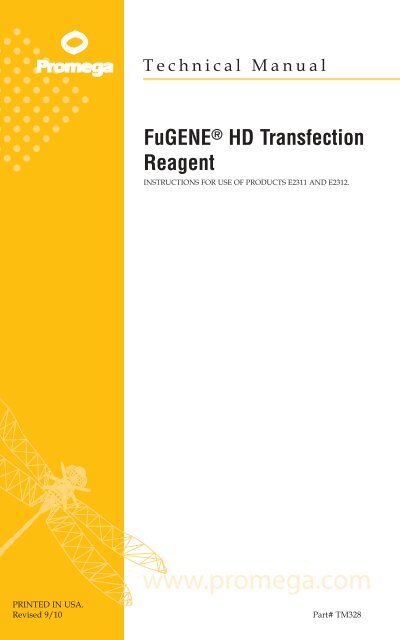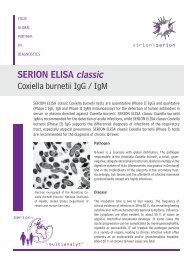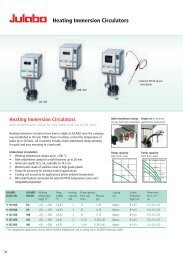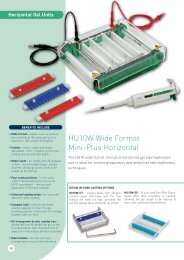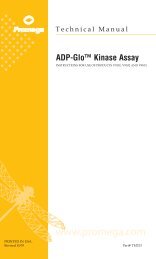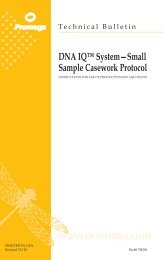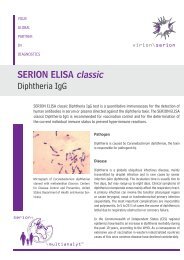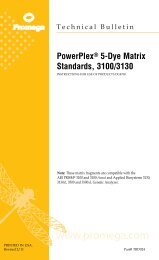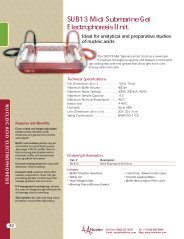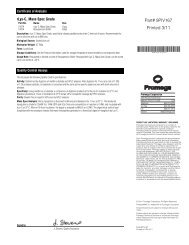FuGENE® HD Transfection Reagent
FuGENE® HD Transfection Reagent
FuGENE® HD Transfection Reagent
Create successful ePaper yourself
Turn your PDF publications into a flip-book with our unique Google optimized e-Paper software.
Technical Manual<br />
FuGENE ® <strong>HD</strong> <strong>Transfection</strong><br />
<strong>Reagent</strong><br />
INSTRUCTIONS FOR USE OF PRODUCTS E2311 AND E2312.<br />
PRINTED IN USA.<br />
Revised 9/10<br />
Part# TM328
FuGENE ® <strong>HD</strong><br />
<strong>Transfection</strong> <strong>Reagent</strong><br />
All technical literature is available on the Internet at: www.promega.com/tbs<br />
Please visit the web site to verify that you are using the most current version of this<br />
Technical Manual. Please contact Promega Technical Services if you have questions on use<br />
of this system. E-mail techserv@promega.com.<br />
1. Description..........................................................................................................1<br />
2. Product Components and Storage Conditions ............................................2<br />
3. General Considerations....................................................................................3<br />
A. Ratio of <strong>Transfection</strong> <strong>Reagent</strong> to DNA .............................................................3<br />
B. DNA........................................................................................................................4<br />
C. Time........................................................................................................................4<br />
D. Serum......................................................................................................................4<br />
E. Antibiotics..............................................................................................................4<br />
F. Stable <strong>Transfection</strong> ...............................................................................................4<br />
4. Recommended Protocol....................................................................................5<br />
A. Plating Cells...........................................................................................................6<br />
B. Preparing the FuGENE ® <strong>HD</strong> <strong>Transfection</strong> <strong>Reagent</strong>........................................6<br />
C. General <strong>Transfection</strong> Protocol ............................................................................7<br />
D. Protocol for Stable <strong>Transfection</strong> .........................................................................8<br />
E. <strong>Transfection</strong> Optimization ..................................................................................9<br />
F. Multiplexing for Easy Optimization ...............................................................10<br />
5. Troubleshooting...............................................................................................11<br />
6. References .........................................................................................................12<br />
7. Related Products ..............................................................................................12<br />
1. Description<br />
FuGENE ® <strong>HD</strong> <strong>Transfection</strong> <strong>Reagent</strong> (a) is a novel, nonliposomal formulation<br />
designed to transfect DNA into a wide variety of cell lines with high efficiency<br />
and low toxicity. The protocol does not require removal of serum or culture<br />
medium and does not require washing or changing of medium after<br />
introducing the reagent/DNA complex. Additionally, the FuGENE ® <strong>HD</strong><br />
<strong>Transfection</strong> <strong>Reagent</strong> has been shown to support transfection in chemically<br />
defined media and does not contain any animal-derived components.<br />
The cell lines listed in Table 1 have been successfully transfected by Promega<br />
Corporation or Fugent, L.L.C. For a list of conditions that were used to transfect<br />
these and other cell types, visit the FuGENE ® <strong>HD</strong> Protocol Database at:<br />
www.promega.com/techserv/tools/Fugene<strong>HD</strong>/<br />
Promega Corporation · 2800 Woods Hollow Road · Madison, WI 53711-5399 USA<br />
Toll Free in USA 800-356-9526 · Phone 608-274-4330 · Fax 608-277-2516 · www.promega.com<br />
Printed in USA.<br />
Part# TM328<br />
Revised 9/10 Page 1
Table 1. Cell Lines Successfully Transfected Using the FuGENE ® <strong>HD</strong> <strong>Transfection</strong><br />
<strong>Reagent</strong> by Promega Corporation or Fugent, L.L.C.<br />
NIH3T3 U-937<br />
HEK293<br />
STSAR90<br />
CHO-K1<br />
AGS<br />
CHO-S<br />
BHK-21<br />
SNU-16<br />
Caco-2<br />
A-375 Caki-1<br />
T98G<br />
Capan-1<br />
HeLa<br />
H4<br />
HepG2<br />
Human skeletal muscle myoblasts (HSMM)<br />
High Five<br />
NCI-N87<br />
MCF7<br />
Panc-1<br />
mES<br />
SK MEL-28<br />
hES<br />
SK-OV-3<br />
PC3 T-24<br />
RAW 264.7 T-84<br />
SCC61<br />
U-87 MG<br />
SQ20B<br />
A549<br />
STO DMS 53<br />
U-2 OS T47D<br />
COS-7<br />
Jurkat<br />
293F<br />
Huh7<br />
2. Product Components and Storage Conditions<br />
Product Size Cat.#<br />
FuGENE ® <strong>HD</strong> <strong>Transfection</strong> <strong>Reagent</strong> 1ml E2311<br />
5 × 1ml E2312<br />
The 1ml size contains sufficient reagent to transfect 333µg of DNA. This is<br />
equivalent to over 3,300 wells in 96-well plates at a 3:1 FuGENE ® <strong>HD</strong> <strong>Transfection</strong><br />
<strong>Reagent</strong>:DNA ratio (0.3µl reagent:100ng DNA per well). The actual number of<br />
transfections will vary with reagent:DNA ratio, transfection volume and cell type.<br />
Storage Conditions: Store FuGENE ® <strong>HD</strong> <strong>Transfection</strong> <strong>Reagent</strong> at 4°C. Close lid<br />
tightly after use. Do not freeze or store below 0°C; components may precipitate.<br />
If reagent has been frozen accidentally, briefly warm at 37°C to dissolve<br />
precipitate.<br />
Promega Corporation · 2800 Woods Hollow Road · Madison, WI 53711-5399 USA<br />
Toll Free in USA 800-356-9526 · Phone 608-274-4330 · Fax 608-277-2516 · www.promega.com<br />
Part# TM328<br />
Printed in USA.<br />
Page 2<br />
Revised 9/10
Formulation and Packaging: FuGENE ® <strong>HD</strong> <strong>Transfection</strong> <strong>Reagent</strong> is a<br />
proprietary mixture of lipids and other components in 80% ethanol, sterile<br />
filtered and supplied in sterile glass vials. It does not contain any ingredients of<br />
human or animal origin.<br />
Special Handling: Allow FuGENE ® <strong>HD</strong> <strong>Transfection</strong> <strong>Reagent</strong> to reach room<br />
temperature, and mix briefly by inverting or vortexing prior to use. No<br />
precipitate should be visible. If reagent was frozen accidentally, briefly warm at<br />
37°C to dissolve precipitate and cool to room temperature. Use a standard<br />
24-well tissue culture plate to serve as a rack for FuGENE ® <strong>HD</strong> <strong>Transfection</strong><br />
<strong>Reagent</strong>. Do not dispense FuGENE ® <strong>HD</strong> <strong>Transfection</strong> <strong>Reagent</strong> into aliquots<br />
from the original glass vials. Minimize contact of undiluted FuGENE ® <strong>HD</strong><br />
<strong>Transfection</strong> <strong>Reagent</strong> with plastic surfaces. Do not use siliconized pipette tips or<br />
tubes. Always dilute FuGENE ® <strong>HD</strong> <strong>Transfection</strong> <strong>Reagent</strong> directly into medium<br />
without contacting the side of the tube. Note: FuGENE ® <strong>HD</strong> <strong>Transfection</strong><br />
<strong>Reagent</strong> also can be used prediluted in transfection medium but should be used<br />
immediately.<br />
3. General Considerations<br />
Successful transfection involves optimizing the FuGENE ® <strong>HD</strong> <strong>Transfection</strong><br />
<strong>Reagent</strong>:DNA ratio, amount of DNA used, complexing time, cells and medium<br />
used, etc. For a detailed optimization protocol, see Section 4.E. Plasmids with<br />
reporter gene functions can be used to monitor transfection efficiencies. An<br />
ideal reporter gene product is unique to the cell, can be expressed from plasmid<br />
DNA and can be assayed conveniently. Generally, such assays are performed<br />
1–2 days after transfection. Promega offers reporter genes and assays for<br />
luciferase, green fluorescent protein (hMGFP), chloramphenicol<br />
acetyltransferase (CAT) and β-galactosidase as well as reagents for covalent<br />
protein labeling (HaloTag ® protein).<br />
For a list of conditions that were used to transfect various cell types, visit the<br />
FuGENE ® <strong>HD</strong> Protocol Database at:<br />
www.promega.com/techserv/tools/Fugene<strong>HD</strong>/<br />
3A. Ratio of <strong>Transfection</strong> <strong>Reagent</strong> to DNA<br />
For successful transfection of DNA into cultured cells, the ratio of FuGENE ®<br />
<strong>HD</strong> <strong>Transfection</strong> <strong>Reagent</strong>:DNA must be optimized. Ratios of 1.5:1 to 4:1<br />
FuGENE ® <strong>HD</strong> <strong>Transfection</strong> <strong>Reagent</strong>:DNA work well with many cell lines, but<br />
ratios outside of this range (4.5:1 to 6:1) may be optimal for other cell types or<br />
applications.<br />
Promega Corporation · 2800 Woods Hollow Road · Madison, WI 53711-5399 USA<br />
Toll Free in USA 800-356-9526 · Phone 608-274-4330 · Fax 608-277-2516 · www.promega.com<br />
Printed in USA.<br />
Part# TM328<br />
Revised 9/10 Page 3
3.B.<br />
DNA<br />
Plasmid DNA for transfections should be free of protein, RNA and chemical<br />
contamination (A 260 /A 280 ratio of 1.7–1.9). The PureYield Plasmid Purification<br />
Systems will provide DNA of sufficient quality for most cell systems. Prepare<br />
purified DNA in sterile water or TE buffer at a final concentration of 0.2–1mg/ml.<br />
The optimal amount of DNA to use in the transfection will vary widely,<br />
depending upon the type of DNA and target cell line used. For adherent cells,<br />
we recommend initially testing 100ng of DNA per well in a 96-well plate format<br />
at a FuGENE ® <strong>HD</strong> <strong>Transfection</strong> <strong>Reagent</strong>:DNA ratio of 3:1 and 2.5:1. Increasing<br />
the amount of DNA does not necessarily result in higher transfection efficiencies.<br />
3.C.<br />
Time<br />
The time required to form the FuGENE ® <strong>HD</strong> <strong>Transfection</strong> <strong>Reagent</strong>:DNA<br />
complex is 0–15 minutes at 22°C. The optimal time varies for each cell line.<br />
Incubate transfected cells for 24–48 hours before assaying to allow time to<br />
express the transfected DNA.<br />
3.D. Serum<br />
<strong>Transfection</strong> protocols often require serum-free conditions for optimal<br />
performance because serum can interfere with many commercially available<br />
transfection reagents. FuGENE ® <strong>HD</strong> <strong>Transfection</strong> <strong>Reagent</strong> can be used in<br />
transfection protocols in the presence of serum (up to 100%), allowing<br />
transfection of cell types that require continuous exposure to serum, such as<br />
primary cell cultures.<br />
3.E.<br />
3.F.<br />
Antibiotics<br />
Antibiotics can be used during the culture of cell lines. The presence of<br />
antibiotics during transfection may adversely affect transfection efficiency and<br />
the overall health of transfected cells. We do not recommend using antibiotics<br />
in the transfection medium unless previously tested in the cell type being<br />
transfected.<br />
Stable <strong>Transfection</strong><br />
FuGENE ® <strong>HD</strong> <strong>Transfection</strong> <strong>Reagent</strong> can be used to produce stable<br />
transfectants. However, we recommend optimizing transfection conditions<br />
using transient transfection studies prior to applying selective pressure to<br />
generate stable transfectants.<br />
Promega Corporation · 2800 Woods Hollow Road · Madison, WI 53711-5399 USA<br />
Toll Free in USA 800-356-9526 · Phone 608-274-4330 · Fax 608-277-2516 · www.promega.com<br />
Part# TM328<br />
Page 4<br />
Printed in USA.<br />
Revised 9/10
4. Recommended Protocol<br />
Figure 1 provides an overview of the transfection procedure. We recommend<br />
using a 96-well plate format to optimize transfection conditions for a particular<br />
cell type.<br />
Plate cells one day before the<br />
transfection experiment so that<br />
cells will be approximately 80%<br />
confluent on the day of transfection.<br />
On the day of transfection, dilute DNA to<br />
2µg per 100µl of serum-free medium.<br />
(Sterile water or Opti-MEM ® I reduced-serum<br />
medium also can be used.)<br />
Add an appropriate amount of FuGENE ®<br />
<strong>HD</strong> <strong>Transfection</strong> <strong>Reagent</strong> to achieve<br />
the proper ratio of reagent to DNA.<br />
Incubate for 0–15 minutes.<br />
Add 2–10µl of FuGENE ® <strong>HD</strong> <strong>Transfection</strong><br />
<strong>Reagent</strong>:DNA mixture to each well<br />
of cells to be transfected, and mix gently.<br />
There is no need to remove serum or<br />
change culture conditions. Incubate<br />
for 24–48 hours or an appropriate<br />
time to measure results. Removal<br />
of transfection complex is not required.<br />
Measure experimental results.<br />
8611TA<br />
Figure 1. Overview of adherent cell transfection protocol for a 96-well plate.<br />
Promega Corporation · 2800 Woods Hollow Road · Madison, WI 53711-5399 USA<br />
Toll Free in USA 800-356-9526 · Phone 608-274-4330 · Fax 608-277-2516 · www.promega.com<br />
Printed in USA.<br />
Part# TM328<br />
Revised 9/10 Page 5
4. Recommended Protocol (continued)<br />
Materials to Be Supplied by the User<br />
• cell culture medium with serum appropriate for the cell type being transfected<br />
• serum-free cell culture medium for complex formation (Opti-MEM ® I reducedserum<br />
medium, standard medium or sterile water can be used.)<br />
• 96-well or other culture plates<br />
• 24-well culture plate to serve as a rack for FuGENE ® <strong>HD</strong> <strong>Transfection</strong> <strong>Reagent</strong><br />
4.A. Plating Cells<br />
Plate adherent cells one day before transfection so that cells are<br />
approximately 80% confluent on the day of transfection. Suspension cells<br />
can be plated the day of transfection. As a general guideline, plate<br />
1–2×10 4 adherent cells or 2 × 10 4 to 1 × 10 5 suspension cells in 100µl per<br />
well of a 96-well plate. Adjust cell numbers proportionately for different<br />
size plates (see Table 2). To prepare cells, collect enough cells to complete<br />
the transfection experiment, and centrifuge for 5 minutes at 300 × g in a<br />
swinging-bucket rotor. Suspend the cell pellet to an appropriate<br />
concentration in medium, then plate.<br />
For a list of conditions that were used to transfect various cell types, visit<br />
the FuGENE ® <strong>HD</strong> Protocol Database at:<br />
www.promega.com/techserv/tools/Fugene<strong>HD</strong>/<br />
Table 2. Area of Culture Plates for Cell Growth.<br />
Plate Size Growth Area (cm 2 ) 1 Relative Area 2<br />
96-well 0.32 1X<br />
24-well 1.88 5X<br />
12-well 3.83 10X<br />
6-well 9.4 30X<br />
35mm 8.0 25X<br />
60mm 21 65X<br />
100mm 55 170X<br />
1This information was calculated for Corning ® culture dishes.<br />
2 Relative area is expressed as a factor of the total growth area of the 96-well plate<br />
recommended for optimization studies. To determine the proper adherent cell<br />
plating density, multiply 1–2 × 10 4 cells by this factor.<br />
4.B.<br />
Preparing the FuGENE ® <strong>HD</strong> <strong>Transfection</strong> <strong>Reagent</strong><br />
1. Before use, allow the vial of FuGENE ® <strong>HD</strong> <strong>Transfection</strong> <strong>Reagent</strong> to reach<br />
room temperature.<br />
2. Mix by inverting or vortexing briefly. No precipitate should be visible. If<br />
reagent has been frozen accidentally, briefly warm at 37°C to dissolve<br />
precipitate and cool to room temperature.<br />
Promega Corporation · 2800 Woods Hollow Road · Madison, WI 53711-5399 USA<br />
Toll Free in USA 800-356-9526 · Phone 608-274-4330 · Fax 608-277-2516 · www.promega.com<br />
Part# TM328<br />
Printed in USA.<br />
Page 6<br />
Revised 9/10
4.C.<br />
General <strong>Transfection</strong> Protocol<br />
Note: The FuGENE ® <strong>HD</strong> <strong>Transfection</strong> <strong>Reagent</strong> can be used in transfection<br />
protocols in the presence of up to 100% serum, allowing transfection of cell<br />
types that require continuous exposure to serum, such as primary cell cultures.<br />
We strongly recommend that you optimize transfection conditions for each cell<br />
line. If you have optimized transfection parameters as described in Section 4.E,<br />
use the empirically determined conditions for your experimental transfections.<br />
If you choose not to optimize transfection parameters, use the general<br />
conditions recommended below. For a list of conditions that were used to<br />
transfect various cell types, visit the FuGENE ® <strong>HD</strong> Protocol Database at:<br />
www.promega.com/techserv/tools/Fugene<strong>HD</strong>/<br />
1. The total volume of medium, DNA and FuGENE ® <strong>HD</strong> <strong>Transfection</strong><br />
<strong>Reagent</strong> to add per well of a 96-well plate is 2–10µl (Table 3). To a sterile<br />
tube or U- or V-bottom plate, add 90–98µl of medium prewarmed to room<br />
temperature so that the final volume after adding the DNA is 100µl. Add<br />
2µg of plasmid DNA (0.2–1µg/µl) to the medium, and vortex. For a 3:1<br />
FuGENE ® <strong>HD</strong> <strong>Transfection</strong> <strong>Reagent</strong>:DNA ratio, add 6µl of FuGENE ® <strong>HD</strong><br />
<strong>Transfection</strong> <strong>Reagent</strong>, and mix immediately.<br />
Add FuGENE ® <strong>HD</strong> <strong>Transfection</strong> <strong>Reagent</strong> directly to medium. Do not allow<br />
! undiluted FuGENE ® <strong>HD</strong> <strong>Transfection</strong> <strong>Reagent</strong> to contact the sides of the<br />
tube or U- or V-bottom plate.<br />
Table 3. Total Volume of Medium, DNA and FuGENE ® <strong>HD</strong> <strong>Transfection</strong> <strong>Reagent</strong><br />
for 96-Well Plates at a 3:1 FuGENE ® <strong>HD</strong> <strong>Transfection</strong> <strong>Reagent</strong>:DNA Ratio.<br />
Plate Size<br />
Total <strong>Transfection</strong><br />
Volume (Per Well) 1<br />
Amount of DNA<br />
(Per Well) 1 Amount of FuGENE ®<br />
<strong>HD</strong> <strong>Reagent</strong> (Per Well) 1<br />
96-well 2–10µl 0.04–0.2µg 0.15–0.6µl<br />
1See Table 2 for multiplication factors to scale up for larger wells or plates. See Table 4<br />
for FuGENE ® <strong>HD</strong> <strong>Transfection</strong> <strong>Reagent</strong> volumes at different reagent:DNA ratios.<br />
2. Incubate the FuGENE ® <strong>HD</strong> <strong>Transfection</strong> <strong>Reagent</strong>/DNA mixture for<br />
5–15 minutes at room temperature.<br />
Optional: Add mixture to cells without an incubation period.<br />
Note: Longer incubations may adversely affect transfections.<br />
3. Add 2–10µl of the FuGENE ® <strong>HD</strong> <strong>Transfection</strong> <strong>Reagent</strong>/DNA mixture per<br />
well to 96-well plate containing 100µl of cells in growth medium. We<br />
suggest 5µl of mixture as a starting point. Mix by pipetting or using a plate<br />
shaker. Return cells to the incubator for 24–48 hours.<br />
Note: The total growth medium volume may vary depending on well<br />
format and your laboratory's common practices.<br />
4. Measure transfection efficiency using an assay appropriate for the reporter<br />
gene. For transient transfection, cells are typically assayed 24–48 hours after<br />
transfection.<br />
Promega Corporation · 2800 Woods Hollow Road · Madison, WI 53711-5399 USA<br />
Toll Free in USA 800-356-9526 · Phone 608-274-4330 · Fax 608-277-2516 · www.promega.com<br />
Printed in USA.<br />
Part# TM328<br />
Revised 9/10 Page 7
4.D. Protocol for Stable <strong>Transfection</strong><br />
The goal of stable transfection is to isolate and propagate individual clones<br />
containing transfected DNA. Therefore, it is necessary to distinguish<br />
nontransfected cells from those that have taken up the exogenous DNA. This<br />
screening can be accomplished by drug selection when an appropriate drugresistance<br />
marker is included in the transfected DNA.<br />
Typically, cells are maintained in nonselective medium for 1–2 days posttransfection,<br />
then plated in selection medium (medium containing the<br />
appropriate drug). The use of selection medium is continued for 2–3 weeks,<br />
with frequent changes of medium to eliminate dead cells and debris until<br />
distinct colonies can be visualized. Individual colonies then are trypsinized and<br />
transferred to flasks for further propagation or to multiwell plates for limited<br />
dilution cloning in the presence of selective medium.<br />
Several drug-selection markers are commonly used for long-term transfection<br />
studies. For example, cells transfected with recombinant vectors containing the<br />
bacterial gene for aminoglycoside (e.g., neomycin) phosphotransferase can be<br />
selected for stable transformation in the presence of the drug G-418 (1). Similarly,<br />
expression of the gene for hygromycin B phosphotransferase from the<br />
transfected vector will confer resistance to the drug hygromycin B (2). Promega<br />
offers vectors conferring resistance to G-418, hygromycin B or puromycin.<br />
Before using a particular drug for selection purposes, determine the amount of<br />
drug necessary to kill the cells you will be using. This may vary from one cell<br />
type to another. Construct a kill curve using varying concentrations of the drug<br />
to determine the amount needed to select resistant clones. The optimal drug<br />
concentration is generally the amount that induces cell death in >90% of<br />
nontransfected cells within 5–7 days.<br />
For stable transfections, cells should be transfected with a plasmid containing a<br />
gene for drug resistance using the transfection protocols outlined in<br />
Sections 4.C and 4.E.<br />
Optional: As a selection-drug-negative control, transfect cells using DNA that<br />
does not contain the drug-resistance gene.<br />
1. Forty-eight hours post-transfection, harvest adherent cells and plate at<br />
several different dilutions (e.g., 1:2, 1:5, 1:10) in selective medium.<br />
2. For the next 14 days, replace the selective medium every 3 to 4 days.<br />
3. During the second week, monitor cells for distinct colonies of surviving<br />
cells. Complete cell death should occur in cultures transfected with the<br />
negative control plasmid.<br />
4. Transfer individual clones by standard techniques (e.g., using cloning<br />
cylinders or limiting dilution cloning) to 96-well plates, and continue to<br />
maintain cultures in selective medium. Note: If single clones are not<br />
required, pools of stable transfectants can be maintained and frozen.<br />
Promega Corporation · 2800 Woods Hollow Road · Madison, WI 53711-5399 USA<br />
Toll Free in USA 800-356-9526 · Phone 608-274-4330 · Fax 608-277-2516 · www.promega.com<br />
Part# TM328<br />
Page 8<br />
Printed in USA.<br />
Revised 9/10
4.E.<br />
<strong>Transfection</strong> Optimization<br />
We strongly recommend that you optimize transfection conditions for each cell<br />
line. For this initial optimization, we recommend using 50–200ng of DNA per<br />
well at various ratios of FuGENE ® <strong>HD</strong> <strong>Transfection</strong> <strong>Reagent</strong> to DNA (Table 4).<br />
We recommend using standard growth conditions with cells in 96-well plates.<br />
For a detailed discussion on optimization and a spreadsheet to aid data<br />
analysis, please visit: www.promega.com/tools/<br />
For a list of conditions that were used to transfect various cell types, visit the<br />
FuGENE ® <strong>HD</strong> Protocol Database at:<br />
www.promega.com/techserv/tools/Fugene<strong>HD</strong>/<br />
Table 4. Optimization Protocol Using Varying Ratios of FuGENE ® <strong>HD</strong> <strong>Transfection</strong><br />
<strong>Reagent</strong> to DNA.<br />
Ratio of FuGENE ® <strong>HD</strong> <strong>Transfection</strong> <strong>Reagent</strong> to DNA<br />
4:1 3.5:1 3:1 2.5:1 2:1 1.5:1<br />
Medium to a final volume of 1 100µl 100µl 100µl 100µl 100µl 100µl<br />
DNA amount 2µg 2µg 2µg 2µg 2µg 2µg<br />
Volume of FuGENE ® <strong>HD</strong><br />
<strong>Transfection</strong> <strong>Reagent</strong> 1 8µl 7µl 6µl 5µl 4µl 3µl<br />
1 The volumes were calculated for 20 wells (5µl/well) of a 96-well plate for each ratio.<br />
1. For a 96-well plate, the total volume of medium and cells per well prior to<br />
transfection should be 100µl. The volume of DNA and FuGENE ® <strong>HD</strong><br />
<strong>Transfection</strong> <strong>Reagent</strong> complex added should be optimized; 2–10µl per well<br />
is a good starting range, but other volumes may be optimal depending on<br />
the transfection parameters. Calculate the total amount of complex needed<br />
for each transfection condition (Table 2). In a sterile polystyrene tube or a<br />
U- or V-bottom plate, combine the indicated amount of medium<br />
(prewarmed to room temperature) and plasmid DNA. Add the indicated<br />
amount of FuGENE ® <strong>HD</strong> <strong>Transfection</strong> <strong>Reagent</strong>, and vortex immediately or<br />
mix by pipetting.<br />
Add FuGENE ® <strong>HD</strong> <strong>Transfection</strong> <strong>Reagent</strong> directly to medium; do not allow<br />
undiluted FuGENE ® <strong>HD</strong> <strong>Transfection</strong> <strong>Reagent</strong> to contact the sides of the<br />
tube or plate). If desired, FuGENE ® <strong>HD</strong> <strong>Transfection</strong> <strong>Reagent</strong> also can be<br />
diluted in transfection medium prior to mixing with diluted DNA.<br />
Note: The FuGENE ® <strong>HD</strong> Protocol Database reports the amount of DNA,<br />
FuGENE ® <strong>HD</strong> <strong>Transfection</strong> <strong>Reagent</strong> and culture medium and optimal time<br />
needed to prepare the FuGENE ® <strong>HD</strong> <strong>Transfection</strong> <strong>Reagent</strong>/DNA complex<br />
for certain cell types. Conditions will vary for different cell types.<br />
!<br />
2. Allow the FuGENE ® <strong>HD</strong> <strong>Transfection</strong> <strong>Reagent</strong>/DNA complex to incubate<br />
at room temperature for 0–15 minutes. Incubations longer than 30 minutes<br />
may result in decreased transfection efficiency. <strong>Transfection</strong> efficiency may<br />
improve in some cell types by adding the complex immediately to cells.<br />
Promega Corporation · 2800 Woods Hollow Road · Madison, WI 53711-5399 USA<br />
Toll Free in USA 800-356-9526 · Phone 608-274-4330 · Fax 608-277-2516 · www.promega.com<br />
Printed in USA.<br />
Part# TM328<br />
Revised 9/10 Page 9
4.E.<br />
4.F.<br />
<strong>Transfection</strong> Optimization (continued)<br />
3. Briefly vortex or mix the FuGENE ® <strong>HD</strong> <strong>Transfection</strong> <strong>Reagent</strong>/DNA complex.<br />
Add 2–10µl of complex per well to 96-well plate containing 100µl of cells in<br />
growth medium. Mix by pipetting or using a plate shaker for 10–30 seconds.<br />
Return plates to the incubator. For many reporter systems (luciferase, CAT,<br />
β-galactosidase, etc.) a 24- to 48-hour incubation is sufficient.<br />
4. Check the transfection efficiency using an assay appropriate for the reporter<br />
system. For multiplexing two reporter assays or one reporter assay with cell<br />
viability or toxicity measurement, see Section 4.F.<br />
Multiplexing for Easy Optimization<br />
The optimal transfection protocol will give the highest transgene expression<br />
with the lowest possible toxicity. In general a 96-well plate provides a sufficient<br />
number of sample wells to perform optimization and provides a relatively easy<br />
format for performing cell-based assays. To accurately establish optimal<br />
conditions, we find it practical to use a multiplex assay to measure cell viability<br />
and reporter gene activity from a single sample in a single well. The procedure<br />
to do this using the CellTiter-Fluor Cell Viability Assay (Cat.# G6080) and<br />
ONE-Glo Luciferase Assay System (Cat.# E6110) is as follows:<br />
1. Follow the instructions in Section 4.E to create a plate with titrations and<br />
replicates of different transfection conditions. Use a plasmid DNA encoding<br />
a constitutive reporter gene such as the pGL4.13[luc2/SV40] Vector (Cat.#<br />
E6681).<br />
2. Culture cells for 24–48 hours.<br />
3. Add 20µl of CellTiter-Fluor <strong>Reagent</strong> (prepared as 10µl of substrate in 2ml<br />
of Assay Buffer) to all wells, and mix briefly by orbital shaking. Incubate for<br />
at least 30 minutes at 37°C.<br />
Note: Longer incubations may improve assay sensitivity and dynamic<br />
range. However, do not incubate longer than 3 hours, and be sure to shield<br />
plates from ambient light.<br />
4. Measure resulting fluorescence using a fluorometer or multimode plate<br />
reader, such as a GloMax ® -Multi+ Detection System<br />
(380–400nm Ex/505nm Em, see Section 7 ).<br />
Note: You may need to adjust instrument gains (applied photomultiplier<br />
tube energy).<br />
5. Add an equal volume of ONE-Glo Luciferase Assay <strong>Reagent</strong> prepared as<br />
described in Technical Bulletin #TM292 to wells (100–120µl per well),<br />
incubate for 3 minutes, then measure luminescence using a luminometer or<br />
multimode plate reader, such as a GloMax ® -Multi+ Detection System.<br />
6. Determine the condition that provides the highest luciferase activity and<br />
viability. To assist data analysis, a spreadsheet that plots data from this<br />
experiment is available at: www.promega.com/techserv/tools/. Note the<br />
instructions and plate layout in the spreadsheet need to be strictly followed.<br />
Promega Corporation · 2800 Woods Hollow Road · Madison, WI 53711-5399 USA<br />
Toll Free in USA 800-356-9526 · Phone 608-274-4330 · Fax 608-277-2516 · www.promega.com<br />
Part# TM328<br />
Page 10<br />
Printed in USA.<br />
Revised 9/10
5. Troubleshooting<br />
For questions not addressed here, please contact your local Promega Branch Office or Distributor.<br />
Contact information available at: www.promega.com. E-mail: techserv@promega.com<br />
Symptoms<br />
No transfection or low<br />
transfection efficiency<br />
Causes and Comments<br />
Poor-quality DNA. The purified DNA should<br />
be transfection-quality. We routinely use the<br />
PureYield Plasmid Midiprep or Maxiprep<br />
Systems to generate transfection-quality DNA<br />
for many cell lines.<br />
The A 260 /A 280 ratio of the DNA should be 1.7–1.9.<br />
FuGENE ® <strong>HD</strong> <strong>Transfection</strong> <strong>Reagent</strong> was frozen.<br />
Do not freeze or store below 0°C. If reagent was<br />
frozen accidentally, briefly warm at 37°C to<br />
dissolve any precipitate.<br />
Suboptimal ratio of FuGENE ® <strong>HD</strong> <strong>Transfection</strong><br />
<strong>Reagent</strong> to DNA. Optimize the FuGENE ® <strong>HD</strong><br />
<strong>Transfection</strong> <strong>Reagent</strong>:DNA ratio. Ratios of 2:1<br />
and 3:1 work well for many cell lines, but ratios<br />
outside this range may be optimal for a<br />
particular cell type or application.<br />
Excessive cell death. FuGENE ® <strong>HD</strong> <strong>Transfection</strong><br />
<strong>Reagent</strong> is one of the more gentle methods of<br />
DNA transfection into cells. In the event of cell<br />
death, optimize conditions as follows.<br />
• Lower the amount of input DNA and<br />
FuGENE ® <strong>HD</strong> <strong>Transfection</strong> <strong>Reagent</strong> while<br />
holding the ratio constant.<br />
• Increase cell density for the transfection step.<br />
• Serum concentration in culture medium was<br />
too low for the cell line used. Transfect cells<br />
in the presence of serum to determine if<br />
transfection in the presence of serum is<br />
successful.<br />
Excessive cell death. Transfected gene products<br />
may be toxic.<br />
Variable transfection efficiencies Suboptimal growth of cells.<br />
in replicate experiments • Check that cultures are Mycoplasma-free.<br />
• Use cultured cells at low passage number.<br />
Variable cell density. Maintain a consistent cell<br />
density at the time of transfection for each<br />
experiment.<br />
Promega Corporation · 2800 Woods Hollow Road · Madison, WI 53711-5399 USA<br />
Toll Free in USA 800-356-9526 · Phone 608-274-4330 · Fax 608-277-2516 · www.promega.com<br />
Printed in USA.<br />
Part# TM328<br />
Revised 9/10 Page 11
6. References<br />
1. Southern, P.J. and Berg, P. (1982) Transformation of mammalian cells to antibiotic<br />
resistance with a bacterial gene under control of the SV40 early region promoter.<br />
J. Mol. Appl. Genet. 1, 327–41.<br />
2. Blochlinger, K. and Diggelmann, H. (1984) Hygromycin B phosphotransferase as a<br />
selectable marker for DNA transfer experiments with higher eucaryotic cells. Mol.<br />
Cell. Biol. 4, 2929–31.<br />
7. Related Products<br />
pGL4 Luciferase Reporter Vectors<br />
Please visit www.promega.com to see a complete listing of Promega reporter vectors.<br />
Multiple Protein Reporter Mammalian<br />
Cloning Reporter Degradation Gene Selectable<br />
Vector Region Gene Sequence Promoter Marker Cat.#<br />
pGL4.10[luc2] Yes luc2 A No No No E6651<br />
pGL4.11[luc2P] Yes “ hPEST No No E6661<br />
pGL4.12[luc2CP] Yes “ hCL1-hPEST No No E6671<br />
pGL4.13[luc2/SV40] No “ No SV40 No E6681<br />
pGL4.14[luc2/Hygro] Yes “ No No Hygro E6691<br />
pGL4.15[luc2P/Hygro] Yes “ hPEST No Hygro E6701<br />
pGL4.16[luc2CP/Hygro] Yes “ hCL1-hPEST No Hygro E6711<br />
pGL4.17[luc2/Neo] Yes “ No No Neo E6721<br />
pGL4.18[luc2P/Neo] Yes “ hPEST No Neo E6731<br />
pGL4.19[luc2CP/Neo] Yes “ hCL1-hPEST No Neo E6741<br />
pGL4.20[luc2/Puro] Yes “ No No Puro E6751<br />
pGL4.21[luc2P/Puro] Yes “ hPEST No Puro E6761<br />
pGL4.22[luc2CP/Puro] Yes “ hCL1-hPEST No Puro E6771<br />
pGL4.23[luc2/minP] Yes “ No minP No E8411<br />
pGL4.24[luc2P/minP] Yes “ hPEST minP No E8421<br />
pGL4.25[luc2CP/minP] Yes “ hCL1-hPEST minP No E8431<br />
pGL4.26[luc2/minP/Hygro] Yes “ No minP Hygr E8441<br />
pGL4.27[luc2P/<br />
minP/Hygro] Yes “ hPEST minP Hygro E8451<br />
pGL4.28[luc2CP/<br />
minP/Hygro] Yes “ hCL1-hPEST minP Hygro E8461<br />
pGL4.29[luc2P/<br />
CRE/Hygro] No “ hPEST CRE Hygro E8471<br />
pGL4.30[luc2P/<br />
NFAT-RE/Hygro] No “ hPEST NFAT-RE Hygro E8481<br />
Promega Corporation · 2800 Woods Hollow Road · Madison, WI 53711-5399 USA<br />
Toll Free in USA 800-356-9526 · Phone 608-274-4330 · Fax 608-277-2516 · www.promega.com<br />
Part# TM328<br />
Page 12<br />
Printed in USA.<br />
Revised 9/10
pGL4 Luciferase Reporter Vectors (continued)<br />
Multiple Protein Reporter Mammalian<br />
Cloning Reporter Degradation Gene Selectable<br />
Vector Region Gene Sequence Promoter Marker Cat.#<br />
pGL4.31[luc2P/GAL4UAS/<br />
Hygro] No luc2 A hPEST GAL4 UAS Hygro C9351<br />
pGL4.32[luc2P/<br />
NF-κB-RE/Hygro] No “ hPEST NF-κB-RE Hygro E8491<br />
pGL4.33[luc2P/SRE/Hygro] No “ hPEST SRE Hygro E1340<br />
pGL4.34[luc2P/<br />
SRF-RE/Hygro] No “ hPEST SRF-RE Hygro E1350<br />
pGL4.36[luc2P/<br />
MMTV/Hygro] No “ hPEST MMTV Hygro E1360<br />
pGL4.50[luc2P/<br />
CMV/Hygro] No “ hPEST CMV Hygro E1310<br />
pGL4.51[luc2P/<br />
CMV/Neo] No “ hPEST CMV Neo E1320<br />
pGL4.70[hRluc] Yes hRluc B No No No E6881<br />
pGL4.71[hRlucP] Yes “ hPEST No No E6891<br />
pGL4.72[hRlucCP] Yes “ hCL1-hPEST No No E6901<br />
pGL4.73[hRluc/SV40] No “ No SV40 No E6911<br />
pGL4.74[hRluc/TK] No “ No HSV-TK No E6921<br />
pGL4.75[hRluc/CMV] No “ No CMV No E6931<br />
pGL4.76[hRluc/Hygro] Yes “ No No Hygro E6941<br />
pGL4.77[hRlucP/Hygro] Yes “ hPEST No Hygro E6951<br />
pGL4.78[hRlucCP/Hygro] Yes “ hCL1-hPEST No Hygro E6961<br />
pGL4.79[hRluc/Neo] Yes “ No No Neo E6971<br />
pGL4.80[hRlucP/Neo] Yes “ hPEST No Neo E6981<br />
pGL4.81[hRlucCP/Neo] Yes “ hCL1-hPEST No Neo E6991<br />
pGL4.82[hRluc/Puro] Yes “ No No Puro E7501<br />
pGL4.83[hRlucP/Puro] Yes “ hPEST No Puro E7511<br />
pGL4.84[hRlucCP/Puro] Yes “ hCL1-hPEST No Puro E7521<br />
A luc2 = synthetic firefly luciferase gene.<br />
BhRluc = synthetic Renilla luciferase gene.<br />
Promega Corporation · 2800 Woods Hollow Road · Madison, WI 53711-5399 USA<br />
Toll Free in USA 800-356-9526 · Phone 608-274-4330 · Fax 608-277-2516 · www.promega.com<br />
Printed in USA.<br />
Part# TM328<br />
Revised 9/10 Page 13
7. Related Products (continued)<br />
Luminometers<br />
Product<br />
Cat.#<br />
GloMax ® 20/20 Luminometer<br />
E5311<br />
GloMax ® 96 Microplate Luminometer<br />
E6501<br />
GloMax ® -Multi+ Detection System Base Instrument with Shaking*<br />
E8031<br />
GloMax ® -Multi+ Detection System Base Instrument<br />
with Heating and Shaking*<br />
E9031<br />
GloMax ® -Multi+ Luminescence Module<br />
E8041<br />
GloMax ® -Multi+ Fluorescence Module<br />
E8051<br />
GloMax ® -Multi+ Visible Absorbance Module<br />
E8061<br />
GloMax ® -Multi+ UV-Visible Absorbance Module<br />
E9061<br />
*Cat.# E8031 and E9031 cannot be sold separately and must be purchased with at<br />
least one detection module (Cat.# E8041, E8051, E8061 or E9061).<br />
Cell Viability Assays<br />
Product Size Cat.#<br />
CellTiter-Glo ® Luminescent Cell Viability Assay 10ml* G7570<br />
CytoTox-Glo Cytotoxicity Assay 10ml* G9290<br />
CellTiter-Fluor Cell Viability Assay 10ml* G6080<br />
*Available in additional sizes. For Laboratory Use.<br />
Plasmid DNA Purification Systems<br />
Product Size Cat.#<br />
PureYield Plasmid Midiprep System 25 preps* A2492<br />
*Available in additional sizes.<br />
Luciferase Assay Systems<br />
Product Size Cat.#<br />
Steady-Glo ® Luciferase Assay System 10ml* E2510<br />
Bright-Glo Luciferase Assay System** 10ml* E2610<br />
ONE-Glo Luciferase Assay System** 10ml* E6110<br />
Dual-Luciferase ® Reporter Assay System 100 assays* E1910<br />
Luciferase Assay System 100 assays* E1500<br />
Luciferase Assay <strong>Reagent</strong> 1,000 assays E1483<br />
Renilla Luciferase Assay System 100 assays* E2810<br />
QuantiLum ® Recombinant Luciferase 1mg* E1701<br />
EnduRen Live Cell Substrate 0.34mg* E6481<br />
ViviRen Live Cell Substrate 0.37mg* E6491<br />
*Available in additional sizes.<br />
**For Laboratory Use.<br />
Promega Corporation · 2800 Woods Hollow Road · Madison, WI 53711-5399 USA<br />
Toll Free in USA 800-356-9526 · Phone 608-274-4330 · Fax 608-277-2516 · www.promega.com<br />
Part# TM328<br />
Page 14<br />
Printed in USA.<br />
Revised 9/10
Eukaryotic Expression Vectors and Selection <strong>Reagent</strong>s<br />
Product Size Cat.#<br />
pCI-neo Mammalian Expression Vector 20µg E1841<br />
pCI Mammalian Expression Vector 20µg E1731<br />
pSI Mammalian Expression Vector 20µg E1721<br />
pTARGET Mammalian Expression Vector System 20 reactions A1410<br />
pF4A CMV Flexi ® Vector 20µg C8481<br />
pF4K CMV Flexi ® Vector 20µg C8491<br />
pFC8A (HaloTag ® ) CMV Flexi ® Vector 20µg C3631<br />
pFC8K (HaloTag ® ) CMV Flexi ® Vector 20µg C3641<br />
Antibiotic G-418 Sulfate 100mg* V7981<br />
*Available in additional sizes.<br />
Green Fluorescent Protein<br />
Product Size Cat.#<br />
Monster Green ® Fluorescent Protein phMGFP Vector 20µg E6421<br />
(a)FuGENE <strong>HD</strong> ® is sold with a Limited Use Label License (LULL). You shall use this Product in accordance with all<br />
applicable laws, rules and regulations. You may not attempt to reverse engineer this Product. If you are not willing to accept<br />
these conditions, the distributor from whom the Product was purchased will accept the return of the unopened Product and<br />
provide you with a full refund. However, in the event this Product is opened, you agree to be bound by the conditions of this<br />
limited use statement.<br />
© 2009, 2010 Promega Corporation. All Rights Reserved.<br />
CellTiter-Glo, Dual-Luciferase, Flexi, GloMax, HaloTag, Monster Green, QuantiLum and Steady-Glo are registered<br />
trademarks of Promega Corporation. Bright-Glo, CellTiter-Fluor, CytoTox-Glo, EnduRen, ONE-Glo, pTarget, PureYield and<br />
ViviRen are trademarks of Promega Corporation.<br />
Corning is a registered trademark of Corning, Inc. FuGENE is a registered trademark of Fugent, LLC., USA. High Five is a<br />
trademark of Invitrogen Corporation. Opti-MEM is a registered trademark of Invitrogen Corporation. Teflon is a registered<br />
trademark of E. I. du Pont de Nemours and Company Corporation.<br />
Products may be covered by pending or issued patents or may have certain limitations. Please visit our Web site for more<br />
information.<br />
All prices and specifications are subject to change without prior notice.<br />
Product claims are subject to change. Please contact Promega Technical Services or access the Promega online catalog for the<br />
most up-to-date information on Promega products.<br />
Promega Corporation · 2800 Woods Hollow Road · Madison, WI 53711-5399 USA<br />
Toll Free in USA 800-356-9526 · Phone 608-274-4330 · Fax 608-277-2516 · www.promega.com<br />
Printed in USA.<br />
Part# TM328<br />
Revised 9/10 Page 15


